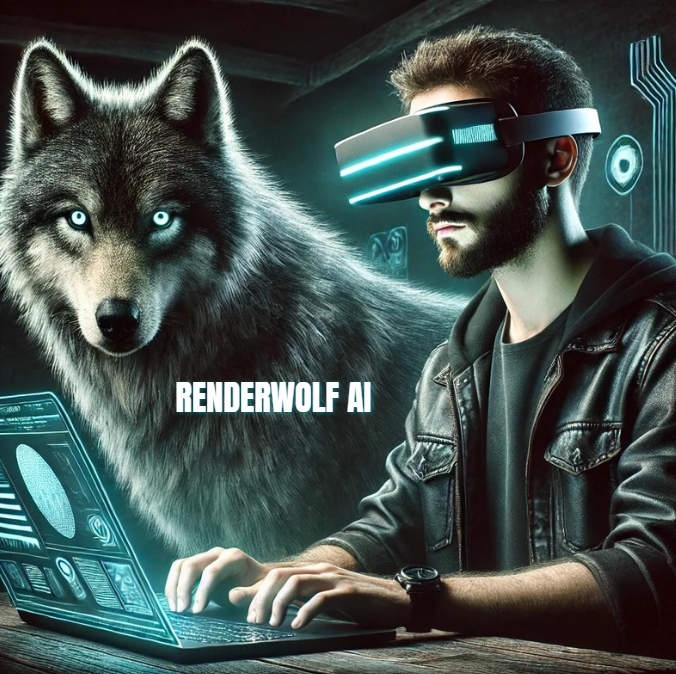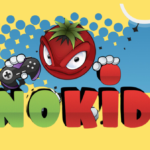The gaming industry has always been at the forefront of technological innovation, constantly evolving to meet the demands of both developers and players. In this ever-changing landscape, tools that can streamline development processes while enhancing creativity are invaluable. One such tool making waves in the industry is Renderwolf AI.
Designed to empower game studios, Renderwolf AI offers a comprehensive suite of capabilities that allow developers to create, reskin, and evolve game assets effortlessly. This article provides an in-depth exploration of Renderwolf AI, its features, applications, and how it is poised to revolutionize game development.
Introduction to Renderwolf AI
What is Renderwolf AI?
Renderwolf AI is an advanced artificial intelligence-powered tool designed specifically for the game development industry. It offers game studios the ability to create, reskin, and evolve assets with unprecedented ease and efficiency.
Whether you’re a small indie developer or part of a large AAA studio, Renderwolf AI provides the resources needed to enhance game content, streamline production workflows, and keep up with the fast-paced demands of live operations.
Renderwolf AI stands out in the crowded field of game development tools by focusing on automating and enhancing asset creation. By leveraging state-of-the-art AI algorithms, it can generate high-quality game assets, apply various skins and textures to existing models, and even adapt content to fit different themes or styles. This flexibility not only saves time but also allows developers to explore creative possibilities that might otherwise be limited by resources or time constraints.
The Role of AI in Modern Game Development
Artificial Intelligence (AI) has become a cornerstone of modern game development, influencing everything from game mechanics and character behaviors to asset creation and procedural content generation. AI tools like Renderwolf AI are revolutionizing the way games are developed by automating repetitive tasks, enhancing creativity, and enabling more personalized gaming experiences. As game worlds become increasingly complex and expansive, the role of AI in managing and creating content has grown, allowing developers to focus more on design and storytelling while AI handles the heavy lifting of content creation.
Core Features of Renderwolf AI
Asset Creation and Generation
One of the standout features of Renderwolf AI is its ability to generate game assets from scratch. Using deep learning algorithms, the tool can create everything from characters and environments to props and textures. These assets are not only visually impressive but also optimized for performance, ensuring that they integrate smoothly into various game engines. Developers can specify parameters such as style, theme, and level of detail, allowing Renderwolf AI to tailor assets to fit the specific needs of the project.
Reskinning and Customization
Reskinning, the process of changing the appearance of a game asset while maintaining its core structure, is another area where Renderwolf AI excels. Whether you’re looking to update the look of existing characters or adapt assets to different in-game environments, Renderwolf AI can apply new textures, colors, and materials with minimal input. This feature is particularly valuable for live operations, where constant updates and new content are essential for keeping players engaged.
Evolving and Adapting Game Content
Renderwolf AI goes beyond simple asset creation by allowing developers to evolve and adapt game content over time. This means that assets can be adjusted or expanded to fit new gameplay mechanics, story developments, or aesthetic changes without needing to start from scratch. For example, a character model can be evolved to reflect aging or environmental changes, or an environment can be adapted to fit a new season or storyline. This capability is invaluable for maintaining the relevance and freshness of a game over its lifecycle.
How Renderwolf AI Works
The Technology Behind Renderwolf AI
Renderwolf AI is built on a foundation of cutting-edge machine learning and neural network technologies. The tool uses a combination of generative adversarial networks (GANs), procedural generation algorithms, and style transfer techniques to create and modify game assets. These technologies enable Renderwolf AI to analyze and learn from existing assets, allowing it to generate new content that is both original and consistent with the game’s style.
The AI engine behind Renderwolf AI is trained on vast datasets of game assets, textures, and art styles, which allows it to understand and replicate a wide range of artistic directions. This deep understanding enables the tool to produce assets that not only meet the technical requirements of game development but also align with the creative vision of the developers.
Integration with Existing Game Development Pipelines
One of the key strengths of Renderwolf AI is its ability to integrate seamlessly with existing game development pipelines. The tool is designed to work with popular game engines like Unity, Unreal Engine, and others, allowing developers to import and export assets with ease. Additionally, Renderwolf AI supports standard file formats and workflows, ensuring that assets created or modified by the tool can be used immediately within the game development process.
This integration capability means that studios can incorporate Renderwolf AI into their workflows without the need for extensive retraining or retooling. Whether it’s used for rapid prototyping, content updates, or full-scale asset production, Renderwolf AI enhances the efficiency and creativity of the development process.
User Interface and Ease of Use
Despite its advanced capabilities, Renderwolf AI is designed with user-friendliness in mind. The tool features an intuitive interface that allows developers of all skill levels to access its powerful features. Users can easily specify parameters for asset generation, apply skins, and evolve content using simple controls and sliders. Additionally, Renderwolf AI provides real-time previews, enabling developers to see the effects of their adjustments immediately and make informed decisions.
The user interface is also customizable, allowing studios to tailor the workflow to fit their specific needs. This flexibility ensures that Renderwolf AI can be used effectively in a wide range of projects, from small indie games to large-scale AAA titles.
Benefits of Using Renderwolf AI
Time and Cost Efficiency
One of the most significant benefits of using Renderwolf AI is the time and cost savings it offers. Traditional asset creation is a labor-intensive process that can take days or even weeks, depending on the complexity of the asset. Renderwolf AI automates much of this work, allowing assets to be generated, reskinned, or evolved in a fraction of the time. This efficiency translates into lower development costs and faster time-to-market, which is crucial in the highly competitive gaming industry.
By reducing the need for manual asset creation, Renderwolf AI also frees up artists and developers to focus on more creative and strategic aspects of game development. This shift not only enhances the overall quality of the game but also leads to a more efficient and enjoyable development process.
Enhanced Creativity and Flexibility
Renderwolf AI empowers developers to explore creative possibilities that might otherwise be limited by time or resources. The tool’s ability to generate assets based on specific parameters allows for rapid experimentation with different styles, themes, and designs. This flexibility is particularly valuable in the early stages of development, where prototyping and iteration are essential.
In addition to asset generation, Renderwolf AI’s reskinning and content evolution features provide developers with the tools they need to keep their games fresh and engaging. Whether it’s updating the look of a game for a seasonal event or adapting content to fit a new gameplay mechanic, Renderwolf AI offers the flexibility needed to keep players engaged and excited about new content.
Scalability for Live Operations
For live games that require continuous content updates, Renderwolf AI is an invaluable tool. The ability to quickly generate and modify assets allows studios to respond to player feedback, introduce new features, and maintain the game’s relevance over time. This scalability is crucial for live operations, where the success of a game depends on its ability to deliver fresh and engaging content regularly.
Renderwolf AI also enables studios to scale their content production efforts without significantly increasing costs. By automating much of the asset creation process, the tool allows studios to produce more content with the same resources, ensuring that they can keep up with the demands of live operations without compromising quality.
Applications of Renderwolf AI in Game Development
Indie Game Development
Indie game developers often face significant challenges when it comes to asset creation, particularly when working with limited budgets and small teams. Renderwolf AI offers a solution by providing these developers with the tools they need to create high-quality assets without the need for extensive resources. The tool’s ease of use and cost efficiency make it an ideal choice for indie developers looking to bring their creative visions to life.
By leveraging Renderwolf AI, indie developers can focus more on gameplay mechanics, storytelling, and other aspects of game design, while the AI handles the heavy lifting of asset creation. This approach not only accelerates development but also allows indie studios to compete with larger developers by delivering visually impressive games.
AAA Game Studios
For AAA game studios, Renderwolf AI offers a way to enhance and streamline their existing development processes. The tool’s advanced asset creation and reskinning capabilities allow large teams to produce more content in less time, ensuring that they can meet tight production schedules and deliver games that meet the high expectations of their audiences.
In addition to speeding up asset production, Renderwolf AI’s ability to evolve content over time is particularly valuable for AAA studios. As games become increasingly complex and expansive, the need for adaptive content that can evolve with the game world becomes more critical. Renderwolf AI provides the tools needed to create dynamic, evolving content that keeps players engaged and invested in the game.
Live Operations and Continuous Content Updates
Live operations require a constant stream of new content to keep players engaged and coming back for more. Renderwolf AI is perfectly suited for this environment, offering the scalability and flexibility needed to support continuous content updates. Whether it’s creating new skins for a seasonal event, adding new characters or environments, or evolving existing content to fit new gameplay mechanics, Renderwolf AI provides the tools needed to keep live games fresh and exciting.
The tool’s ability to quickly generate and modify assets also allows studios to respond to player feedback and market trends in real-time, ensuring that their games remain relevant and competitive in a fast-paced industry.
Renderwolf AI vs. Traditional Game Development Tools
Key Differences and Advantages
Renderwolf AI differs from traditional game development tools in several key ways. While traditional tools often require extensive manual input and specialized skills, Renderwolf AI automates much of the asset creation process, making it accessible to developers of all skill levels. The tool’s use of AI and machine learning also allows it to generate and modify assets with a level of speed and efficiency that traditional tools cannot match.
In addition to its efficiency, Renderwolf AI offers a level of creativity and flexibility that is difficult to achieve with traditional tools. The ability to generate assets based on specific parameters, reskin existing models, and evolve content over time gives developers the freedom to explore new ideas and iterate quickly.
How Renderwolf AI Complements Existing Tools
Renderwolf AI is not meant to replace traditional game development tools but rather to complement them. The tool can be integrated into existing workflows, allowing developers to use it alongside their favorite game engines, modeling software, and other development tools. This integration ensures that studios can take advantage of Renderwolf AI’s advanced capabilities without needing to overhaul their entire development process.
By complementing traditional tools, Renderwolf AI enhances the overall efficiency and creativity of the development process, allowing studios to produce high-quality games more quickly and at a lower cost.
Real-World Use Cases and Success Stories
Renderwolf AI has already been adopted by a number of game studios, both indie and AAA, with impressive results. For example, an indie studio used Renderwolf AI to create all the character models and environments for their game, allowing them to focus on gameplay mechanics and narrative design. The result was a visually stunning game that received critical acclaim and commercial success.
In the AAA space, Renderwolf AI has been used to support live operations for a popular online game. The tool’s ability to quickly generate new skins and evolve existing content allowed the studio to deliver regular updates and keep players engaged, resulting in increased player retention and revenue.
These success stories demonstrate the value of Renderwolf AI in a wide range of development environments, from small indie projects to large-scale live operations.
The Future of AI in Game Development
Emerging Trends and Innovations
As AI continues to advance, its role in game development is expected to grow even further. Emerging trends such as procedural content generation, AI-driven storytelling, and intelligent NPC behavior are likely to shape the future of gaming, making games more dynamic, responsive, and personalized.
Renderwolf AI is well-positioned to take advantage of these trends, offering developers the tools they need to stay at the cutting edge of game development. As AI technology continues to evolve, Renderwolf AI is likely to introduce new features and capabilities that push the boundaries of what is possible in game development.
The Role of AI in Next-Generation Gaming
The next generation of gaming is expected to be defined by greater immersion, interactivity, and personalization. AI will play a central role in achieving these goals, enabling developers to create games that adapt to players’ choices, behaviors, and preferences in real-time. Renderwolf AI is already contributing to this vision by providing the tools needed to create dynamic, evolving game worlds that respond to player input.
In addition to enhancing gameplay, AI is also likely to play a role in optimizing game performance, improving accessibility, and enabling new forms of multiplayer and social gaming experiences. As AI continues to integrate with other emerging technologies such as virtual reality (VR) and augmented reality (AR), the possibilities for next-generation gaming are virtually limitless.
Ethical Considerations and Challenges
As with any powerful technology, the use of AI in game development raises important ethical considerations. Issues such as the potential for AI to replace human jobs, the impact of AI-generated content on creativity, and the need for transparency and accountability in AI systems must be carefully considered.
Renderwolf AI is committed to addressing these challenges by developing AI tools that enhance, rather than replace, human creativity. The tool is designed to work alongside human developers, providing them with the resources they need to create better games while maintaining control over the creative process. Additionally, Renderwolf AI is focused on ensuring that its AI-generated content is original, ethical, and aligned with the values of the gaming community.
FAQs About Renderwolf AI
What types of assets can Renderwolf AI create?
Renderwolf AI can create a wide range of game assets, including characters, environments, props, textures, and more. The tool’s AI algorithms allow it to generate assets in a variety of styles and themes, making it suitable for a diverse range of game genres and artistic directions.
Is Renderwolf AI suitable for both small and large studios?
Yes, Renderwolf AI is designed to be scalable and flexible, making it suitable for both small indie developers and large AAA studios. The tool’s ease of use and cost efficiency make it an ideal choice for smaller teams, while its advanced capabilities and integration options make it valuable for larger studios with more complex development needs.
How does Renderwolf AI handle asset reskinning?
Renderwolf AI uses AI-driven algorithms to apply new textures, colors, and materials to existing assets, allowing for quick and easy reskinning. The tool’s reskinning feature is particularly valuable for live operations, where new skins and visual updates are often needed to keep players engaged.
Can Renderwolf AI be integrated with popular game engines?
Yes, Renderwolf AI is designed to integrate seamlessly with popular game engines such as Unity and Unreal Engine. The tool supports standard file formats and workflows, making it easy to import and export assets between Renderwolf AI and your existing development pipeline.
What are the pricing models for Renderwolf AI?
Renderwolf AI offers a variety of pricing models to suit the needs of different developers. These may include subscription-based plans, one-time purchases, or custom pricing for larger studios. Pricing is typically based on the features and level of support required.
How does Renderwolf AI ensure the originality of generated assets?
Renderwolf AI uses advanced AI algorithms to generate original assets based on the parameters specified by the developer. The tool is designed to create unique and original content, ensuring that assets are not simply copies of existing designs. This originality is important for maintaining the creative integrity of the game and ensuring that the final product stands out in the market.
Conclusion
Summary of Key Points
Renderwolf AI is a groundbreaking tool that is set to revolutionize the game development industry. By automating and enhancing the asset creation process, Renderwolf AI allows developers to produce high-quality content more efficiently and cost-effectively.
The tool’s advanced capabilities, including asset generation, reskinning, and content evolution, make it an invaluable resource for both indie developers and AAA studios. As AI continues to shape the future of game development, Renderwolf AI is poised to lead the way, offering developers the tools they need to create the next generation of immersive, dynamic, and engaging games.
The impact of Renderwolf AI on game development is significant and far-reaching. By empowering developers with the tools they need to create, reskin, and evolve assets effortlessly, Renderwolf AI is transforming the way games are made.
The tool’s ability to streamline workflows, enhance creativity, and support live operations makes it a valuable asset for any studio looking to stay competitive in a rapidly evolving industry. As the gaming landscape continues to change, Renderwolf AI will undoubtedly play a key role in shaping the future of game development.

















